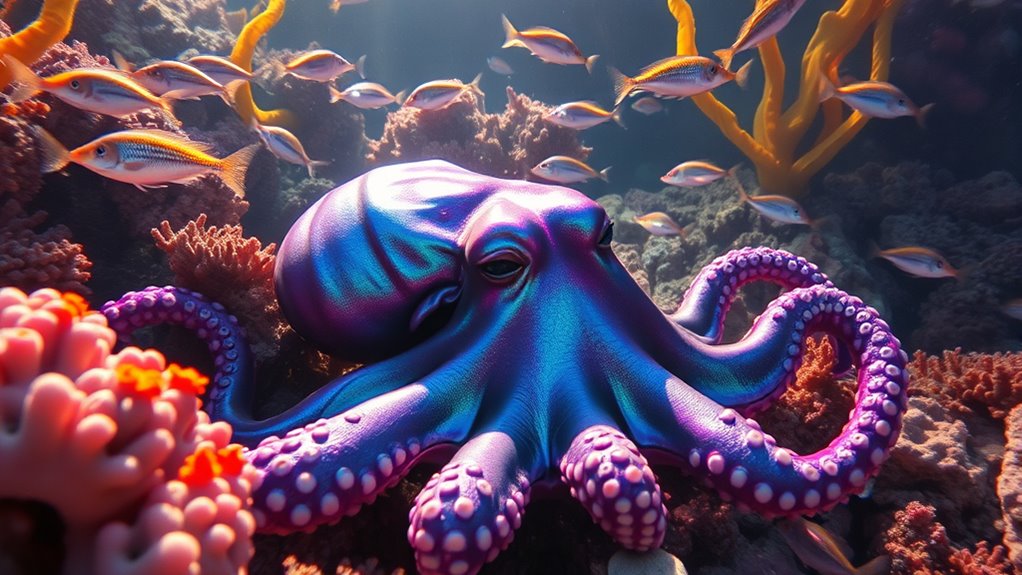Yes, octopuses have three hearts. Two hearts pump blood to the gills for oxygen, while the third heart circulates oxygen-rich blood to the body. This unique system allows for energy conservation, especially when they swim, as the heart pumping to the body stops beating. Their blood is blue due to hemocyanin, a copper-based molecule that helps them thrive in low-oxygen environments. Discover more fascinating details about their anatomy and survival strategies in the ocean.
Key Takeaways
- Yes, octopuses have three hearts that serve distinct functions in their cardiovascular system.
- Two hearts pump blood to the gills for oxygenation, while the third heart delivers oxygen-rich blood to the body.
- Their blood contains hemocyanin, which gives it a blue color and is efficient for oxygen transport in low-oxygen environments.
- While swimming, the heart that feeds the body stops beating to conserve energy, making it an adaptation for movement.
- The unique anatomy of octopuses illustrates their evolutionary adaptations to survive in diverse marine environments.

When you think about octopuses, their unique anatomy might surprise you—especially the fact that they have three hearts. This fascinating feature plays a vital role in their survival and is a key point of interest in marine biology. Each heart has its specific function, working together to guarantee the octopus remains efficient in its underwater environment. Two of the hearts pump blood to the gills, where the blood gets oxygenated, while the third heart pumps the oxygen-rich blood to the rest of the body.
Octopuses have three hearts, each with a unique role, ensuring efficient survival in their underwater world.
The octopus’s cardiovascular system is quite different from what you might find in mammals. In humans, for example, one heart does all the work of circulating blood throughout the body. In contrast, the octopus’s unique structure allows it to thrive in the ocean’s depths. The dual-pumping system means that while one heart is busy pushing blood to the gills, the other two are guaranteeing the rest of the body receives the necessary oxygen. It’s a fascinating adaptation that highlights the incredible diversity of life found in marine environments.
If you explore further into marine biology, you’ll find that the octopus’s blood is also unique. Instead of the iron-based hemoglobin that gives our blood its red color, octopus blood contains hemocyanin, which is copper-based. This change is essential for oxygen transport in cold, low-oxygen environments. The blue color of their blood is a striking visual reminder of how these creatures have adapted to their specific habitats.
Having three hearts may sound excessive, but it’s a perfect example of how evolution shapes anatomy based on environmental needs. When an octopus swims, the heart that delivers blood to the body actually stops beating, which explains why these creatures prefer crawling over swimming. The energy expenditure involved in swimming is much higher, and their cardiovascular systems are adapted to conserve energy when it’s needed most.
Understanding the anatomy of octopuses not only enhances your appreciation for their unique biology but also underscores the broader principles of marine life. By studying these exceptional creatures, you gain insight into evolutionary adaptations that allow for survival in diverse and often challenging environments. So next time you hear about octopuses, you’ll remember their remarkable three hearts and the intricate cardiovascular systems that make them such intriguing subjects in marine biology.
Frequently Asked Questions
How Do Octopuses Use Their Hearts?
Octopuses use their hearts to efficiently manage blood flow throughout their bodies. Their unique circulatory system involves one heart pumping blood to the body while the other two manage blood flow to the gills. This setup helps you regulate heart rate based on activity levels. When an octopus swims, its heart rate increases, ensuring that oxygenated blood reaches its essential organs quickly. This adaptation supports their active and agile lifestyle in the ocean.
What Is the Size of an Octopus Heart?
Imagine the octopus as an artist, painting the ocean with its vibrant movements. Each of its hearts, varying in size, plays a vital role in the masterpiece of its blood flow. Typically, an octopus’s hearts are about the size of a grape, but this can vary among species. As you dive deeper into their world, you’ll discover how these hearts circulate oxygen-rich blood, keeping the artist alive and thriving in its watery domain.
Do All Octopuses Have Three Hearts?
Not all octopuses have three hearts, but most species do! This unique trait ties into cephalopod evolution, showcasing how these fascinating creatures adapt. When you explore octopus intelligence, you’ll see how their complex hearts support their active lifestyles. The two hearts pump blood to the gills, while the third pumps it to the rest of the body, enabling their remarkable abilities in hunting and problem-solving. Isn’t nature intriguing?
Can Octopuses Survive With One Heart?
No, octopuses can’t survive with just one heart. Their three hearts are evolutionary adaptations that help them efficiently circulate blood, especially in low-oxygen environments. If one heart fails, the others may not compensate adequately, leading to serious health issues. Understanding these unique features is vital in marine biology, as it highlights how octopuses thrive in various habitats. So, while they’re fascinating creatures, their survival relies heavily on all three hearts functioning properly.
How Does an Octopus Heart Function Underwater?
Ever wondered how an octopus thrives beneath the waves? Its heart pumps blue blood through a unique circulatory system, allowing it to navigate underwater effortlessly. The octopus has three hearts, two of which manage blood circulation to the gills while the third pumps it to the rest of the body. Heart rate regulation is essential; when you see an octopus diving deep, its heart rate slows, conserving energy and enhancing survival.
Conclusion
So, yes, octopuses do have three hearts! Two pump blood to their gills, while the third pumps it to the rest of their body. This unique circulatory system supports their active lifestyle and incredible adaptability in the ocean. As the saying goes, “Don’t judge a book by its cover,” just like you shouldn’t underestimate an octopus by its appearance. Their complex biology and intelligence are as fascinating as the depths they inhabit.










